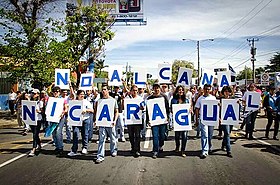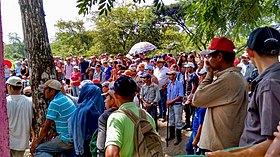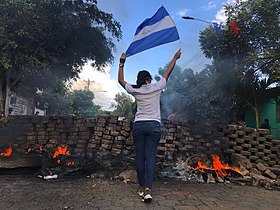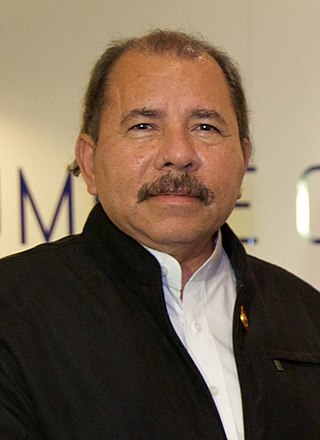
José Daniel Ortega Saavedra is a Nicaraguan politician who has been the 58th President of Nicaragua since 2007. Previously he was leader of Nicaragua from 1979 to 1990, first as Coordinator of the Junta of National Reconstruction from 1979 to 1985, and then as the 54th President from 1985 to 1990. During his first term, he implemented policies to achieve leftist reforms across Nicaragua. In later years, Ortega's left-wing radical politics cooled significantly, leading him to pursue pro-business policies and even rapprochement with the Catholic Church. However, in 2022, Ortega resumed repression of the Church, and has imprisoned prelate Rolando José Álvarez Lagos.

Nicaragua, officially the Republic of Nicaragua, is the geographically largest country in Central America, comprising 130,370 km2 (50,340 sq mi). With a population of 6,850,540 as of 2021, it is the third-most populous country in Central America after Guatemala and Honduras. Nicaragua is bordered by Honduras to the north, the Caribbean Sea to the east, Costa Rica to the south, and the Pacific Ocean and a shared maritime border with El Salvador to the west. The country's largest city and national capital is Managua, the fourth-largest city in Central America with a population of 1,055,247 as of 2020. Nicaragua's multiethnic population includes people of mestizo, indigenous, European, and African heritage. The country's most spoken language is Spanish, though indigenous tribes on the Mosquito Coast speak their own languages and English.

The Sandinista National Liberation Front is a left-wing political party in Nicaragua. Its members are called Sandinistas in both English and Spanish. The party is named after Augusto César Sandino, who led the Nicaraguan resistance against the United States occupation of Nicaragua in the 1930s.

Violeta Barrios Torres de Chamorro is a Nicaraguan former politician who served as President of Nicaragua from 1990 to 1997. She was the first and, to date, only woman to hold the position of president of Nicaragua.
Edén Atanacio Pastora Gómez was a Nicaraguan politician and guerrilla who ran for president as the candidate of the Alternative for Change (AC) party in the 2006 general elections. In the years prior to the fall of the Somoza regime, Pastora was the leader of the Southern Front, the largest militia in southern Nicaragua, second only to the FSLN in the north. Pastora was nicknamed Comandante Cero.

The Nicaraguan Revolution encompassed the rising opposition to the Somoza dictatorship in the 1960s and 1970s, the campaign led by the Sandinista National Liberation Front (FSLN) to oust the dictatorship in 1978–79, the subsequent efforts of the FSLN to govern Nicaragua from 1979 to 1990, and the Contra War, which was waged between the FSLN-led government of Nicaragua and the United States–backed Contras from 1981 to 1990. The revolution marked a significant period in the history of Nicaragua and revealed the country as one of the major proxy war battlegrounds of the Cold War, attracting much international attention.

The Junta of National Reconstruction was the provisional government of Nicaragua from the fall of the Somoza dictatorship in July 1979 until January 1985, with the election of Sandinista National Liberation Front’s Daniel Ortega as president.

General elections were held in Nicaragua on 5 November 2006. The country's voters went to the polls to elect a new President of the Republic and 90 members of the National Assembly. Daniel Ortega (FSLN) won the election with 37.99% of the vote, Eduardo Montealegre (ALN) trailing with 28.30%, José Rizo (PLC) with 27.1%, Edmundo Jarquín (MRS) with 6.29%, and Edén Pastora (AC) with 0.29%.
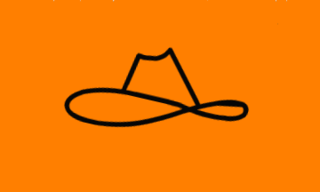
The Sandinista Renovation Movement is a Nicaraguan political party founded on 21 May 1995. It defines itself as a democratic and progressive party, made of people of all genders, that promotes the construction of a Nicaragua with opportunities, progress, solidarity, democracy, and sovereignty.

Rosario María Murillo Zambrana is a Nicaraguan politician and poet who has held the position of Vice President of Nicaragua, the country's second highest office, since January 2017 and First Lady of Nicaragua since 2007 and from 1985 to 1990 as the wife of President Daniel Ortega. Murillo has served as the Nicaraguan government's lead spokesperson, government minister, head of the Sandinista Association of Cultural Workers, and Communications Coordinator of the Council on Communication and Citizenry. She was sworn in as vice president of Nicaragua on 10 January 2017. In August 2021, she was personally sanctioned by the European Union, over alleged human rights violations.

General elections were held in Nicaragua on 6 November 2011. The incumbent president Daniel Ortega, won a third term in this election, with a landslide victory.
Canal 6 is a Nicaraguan terrestrial television channel broadcasting from the city of Managua. The station claims to be owned by the Government of Nicaragua, but is actually owned by a joint stock company called NEPISA
The following lists events in the year 2018 in Nicaragua.

Francisca Ramírez Tórrez is a Nicaraguan farmer and peasants (campesinos) rights activist. She has been a leader of protests that began in 2014 against the proposed development of an inter-oceanic canal through Nicaragua and for the repeal of the 2013 legislation granting Chinese company HKND the concession for the canal and other infrastructure projects.

The Trees of Life are a public art installation in Managua, Nicaragua. Begun in 2013 to honor the 34th anniversary of the Sandinista Revolution, the Trees of Life are a city beautification project of First Lady Rosario Murillo, who has also served as Nicaragua's Vice President since 2017.

The 2018 Nicaraguan protests began on 18 April 2018 following a move by the government of Daniel Ortega to reform social security. Following the deaths of protesters, demonstrations intensified and grew into a large anti-Ortega movement seeking his removal from office.

The 2018 Nicaraguan protests began on 18 April 2018 when demonstrators in several cities of Nicaragua began protests against the social security reforms decreed by President Daniel Ortega that increased taxes and decreased benefits. After five days of unrest in which nearly thirty people were killed, Ortega announced the cancellation of the reforms; however, the opposition has grown through the 2014–2018 Nicaraguan protests to denounce Ortega and demand his resignation, becoming one of the largest protests in his government's history and the deadliest civil conflict since the end of the Nicaraguan Revolution. On 29 September 2018, political demonstrations were declared illegal by President Ortega.

General elections were held in Nicaragua on 7 November 2021 to elect the President, the National Assembly and members of the Central American Parliament.

Medardo Mairena Sequeira is a Nicaraguan farmer and coordinator of the peasant (campesino) movement. Mairena has worked in the peasant anti-canal movement since 2013 and has been an active opposition leader since the national protests broke out in late April 2018, participating in the National Dialogue between protestors and the government of Daniel Ortega, mediated by the Catholic Church. Two months later he became one of a large number of dissidents arrested and prosecuted for terrorism; Mairena was sentenced to 261 years in prison, serving one year before he was released under a negotiated Amnesty Law.
This is a timeline of the 2020 Nicaraguan protests. It covers events from February to December 2020.
